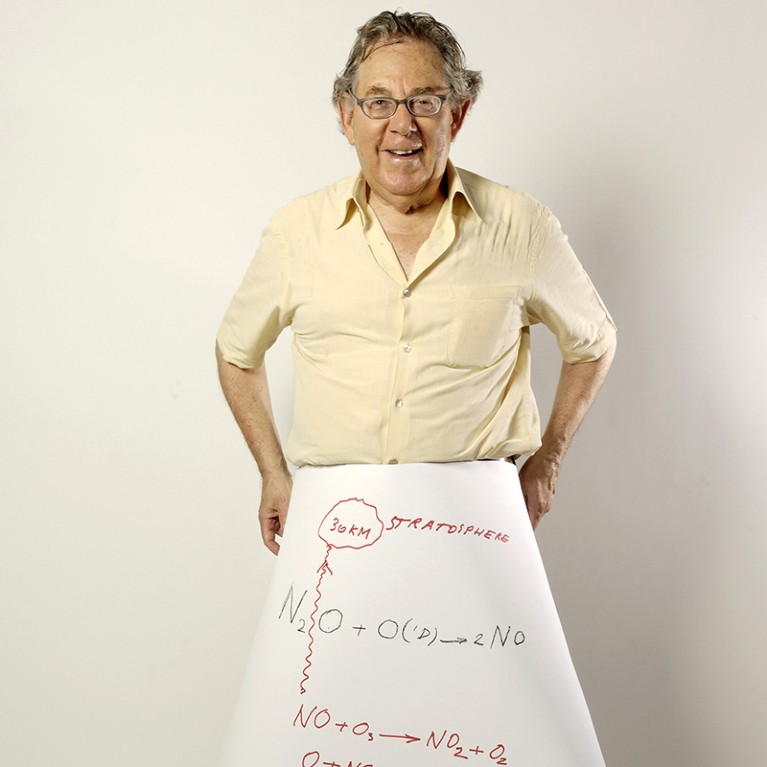
Credit: Volker Steger/SPL
Paul J. Crutzen discovered how atmospheric pollutants can destroy stratospheric ozone, which protects Earth from harmful ultraviolet radiation. He shared the 1995 Nobel Prize in Chemistry for this work with F. Sherwood Rowland and Mario J. Molina, who had shown that such pollutants included chlorofluorocarbons. Combining rigorous research with a gift for communicating, Crutzen championed the term ‘Anthropocene’ to describe what he regarded as a new epoch, characterized by human dominance of biological, chemical and geological processes on Earth1. He has died, aged 87.
At a conference in Cuernavaca, Mexico, in 2000, Crutzen stood up and proclaimed that we live in the “Anthropocene”. The term immediately caught on and stimulated discussion in many disciplines. The “age of humans” is now considered to have begun in the mid-twentieth century, as the exploitation of the planet’s resources accelerated. Crutzen regarded the concept as his most important contribution. It reflected his deep concerns about climate change and other environmental pressures in a world with a population that could reach ten billion in several decades.
Crutzen was born in Amsterdam, in 1933, and trained as a civil engineer. In the 1960s, he studied meteorology at the University of Stockholm, while working as a computer programmer to support his Finnish wife, Terttu Soininen, and family. As a graduate student, he combined his programming and scientific skills by building a computer model of the stratosphere. While seeking to explain the distribution of ozone at different heights, he discovered that nitrogen oxides could catalyse reactions that destroy ozone. In the early 1970s, when scientists began to discuss the levels of nitrogen oxides likely to be emitted by planned fleets of supersonic aircraft, he realized that anthropogenic emissions could damage the stratospheric ozone layer2. His work coincided with that of Molina and Rowland, who found that so, too, could chlorine-containing compounds used as propellants, solvents and refrigerants. In 1985, scientists discovered a ‘hole’ in the ozone layer over the Antarctic3.
Crutzen threw himself into the intense public debate on ozone depletion in the 1970s and 1980s. From 1980, he was director of the Max Planck Institute for Chemistry in Mainz, Germany, and was appointed to a German parliamentary commission on preventive measures for protecting Earth’s atmosphere. Its report, published in 1989, influenced the drafting of policies about the atmosphere and climate (see go.nature.com/2rruji). Crutzen helped to lay the foundations of the 1987 Montreal Protocol, whose signatory states committed to phasing out ozone-depleting substances. As a consequence, harmful chlorine compounds have been banned, supersonic aircraft were limited to a few Concordes and the ozone layer now shows signs of recovery.
Crutzen was also the first to warn of the possibility of what came to be known as nuclear winter. In the 1970s, he had set up a stratospheric research programme for the US National Oceanic and Atmospheric Administration while also working at the National Center for Atmospheric Research in Boulder, Colorado. In parallel, he developed an interest in the chemistry of the lower atmosphere (the troposphere) and climate change, investigating sources of air pollution. One source, previously overlooked by researchers, was the burning of biomass in deforestation and agriculture, mostly in the tropics. He showed that its large-scale influence on tropospheric pollution was particularly significant in the tropics and much of the Southern Hemisphere, where other anthropogenic emissions (from fossil fuels, for example) were less prevalent than in the more industrialized north.
This motivated Crutzen to study the impacts of firestorms that would be ignited in a nuclear conflict. Black carbon in the smoke from these fires would absorb energy from sunlight and loft the smoke plumes to higher altitudes, extending their lifetime and cooling Earth’s surface. A 1982 article co-authored with chemist John Birks, and subtitled ‘Twilight at noon’4, led a team including atmospheric scientist Richard Turco and astrophysicist Carl Sagan to warn of a “nuclear winter” that could follow a conflict between superpowers. Mikhail Gorbachev, who led the Soviet Union from 1985 to 1991, later cited the prospect as a great stimulus to his signing a nuclear arms-control agreement with US president Ronald Reagan in 1987.
After his formal retirement in 2000, Crutzen continued to campaign. In 2006, he called for research into geoengineering, in case efforts to control emissions failed to halt the rise in global temperature. One option considered was to release sulfur dioxide into the stratosphere, where it would be chemically converted to sulfate particles that would shield Earth from the Sun, counteracting the anthropogenic greenhouse effect. Crutzen did not advocate this method, but he wanted to stimulate discovery. Today, some are pursuing the idea; others find it a distraction from the need to tackle the continued growth of emissions.
Paul Crutzen was an exceptionally creative scientist and a warm-hearted person. He tirelessly addressed the challenges of the Anthropocene, in scientific and public debate. The COVID-19 pandemic, too, is a product of the Anthropocene, because the SARS-CoV-2 virus proliferated through global trade and air traffic, despite scientific warnings. Crutzen would expect us to continue taking responsibility for science, society and our planet.

 Mario Molina (1943–2020)
Mario Molina (1943–2020)
 Involve social scientists in defining the Anthropocene
Involve social scientists in defining the Anthropocene
 Developing countries must lead on solar geoengineering research
Developing countries must lead on solar geoengineering research



